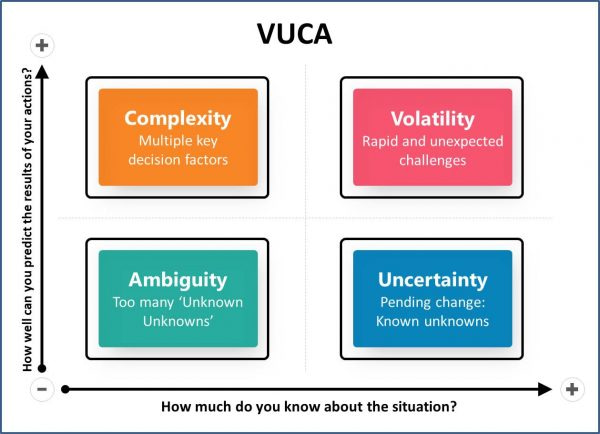Before we delve into Psychological Safety and why it is essential to consider it one of the top priorities for your teams, especially in the current period of volatility, uncertainty, complexity, and ambiguity (VUCA) world.

Let’s take a minute to put ourselves into our work shoes and the work you do with your teams. Ask the following questions to yourselves:
- In team meetings or discussions, do you pretend to understand everything and maintain you have no items to ask?
- Are you comfortable enough to share your thoughts and ideas with the team?
- Can you choose not to attend a meeting without explaining the reason for not visiting anybody on the team or your manager?
- Do you feel safe to cover up a mistake you did rather than sharing it openly with the team?
- Are you comfortable when it comes to asking fellow team members for help?
- Do you know your colleagues enough outside of their professional lives?
After you have answered the above questions, what kind of picture do you see yourself in with your team taking a regular team outing scene? Choose the type of image you envision from the following options:
- A happy team having a good time at a team outing
- A team divided among multiple tables but in their herd
- A team that is here to fill in for the HR request to make sure they attend the official social gathering
- A cool selfie I took for my new DP on WhatsApp
Now, hold on to your picture while we dig deeper into the topic of the day…
What is Psychological Safety?
There are multiple definitions that you can find, but the one that says it all in the shortest possible manner is the one from Dr. Amy Edmondson, a professor at Harvard Business School, which goes like this:
“It describes a team climate characterized by interpersonal trust and mutual respect in which people are comfortable being themselves.”
If we unfold the above definition for Psychological Safety, it implies that the employees are highly engaged and motivated to express their ideas, thoughts, or mistakes without having the fear being held responsible or experiencing humiliation from the team or the management with a sense of trust in the team members.
Why is psychological safety important?

Spare me, but I am going to sound like I am wearing the doctor’s jacket for the next couple of lines, but please stay with me –
Oxytocin is a hormone secreted into our bloodstream by the posterior pituitary gland after being produced by the hypothalamus. The level of secretion depends on the level of neuron electrical activity in the hypothalamus, which is then released to our blood based on the excitement. Some recent studies now mention oxytocin as a primary agent contributing to social behavior.
Having a workplace that offers a kind of challenging environment for employees minus the fear of being threatened in any which way. Oxytocin levels in the body rise owing to the excitement of contributing to innovation and having trust among the team members.
(Enough of the doctor stuff, let us get out of the doctor’s cabin now)
Gallup, a successful management consulting firm based out of Washington, surveyed to understand the impact of psychological safety in organizations, which revealed that three out of ten US employees strongly agree that at work, their opinions seem to count. However, when you push that number to six in ten employees, organizations could achieve a 27% reduction in turnover, a 40% reduction in safety incidents, and a 12% increase in productivity.
Another one of the most extensive studies conducted by Google under the name Project Aristotle, where they spent two years studying about 180 different teams and following was the five traits portrayed by the most successful high-performing teams:

How to build psychological safety for your teams?
There is no magic formula that you can apply. Your team members can get a safe environment to communicate and speak their mind out openly. However, the following are some areas that you could consider to get the ball rolling in the right direction:
Collaboration
For a team to be able to collaborate, a necessary pre-requisite is to make sure the team understands the product vision such that they understand the broader objective of their contributions to instill the feeling of playing for a cause. In case of issues, encourage the team to imagine where they expected themselves to be and then discuss an action plan to achieve that, avoiding the root cause analysis of the issue, which would only add to the negativity and even lead to a blame game among the team members. Everybody loves winning more than losing. Hence, using virtualization techniques to picture themselves on the podium of success keeps people in a positive frame of mind to re-establish a common purpose to achieve and work towards the same. Conduct group discussions to conduct a SWOT analysis of an idea, which may give you many ideas rather than a singular approach.
Trust
To have a sense of safety, everybody must be comfortable to be vulnerable in front of the whole group that ends up gaining confidence with each other as a team. Beneath every confrontation, people do share similar traits of expecting respect, social recognition, and a sense of pride. The team should possess a definite bias towards every individual action in the team because nobody wants to end up getting publicly shamed and end up on a losing side. People should portray openness towards each individual and understand that any failure one had was because someone tried to make an effort to take the team one step closer to the win. It is only that the results achieved were not in our favor but made our team only smarter after the learning we took from the failure.
Freedom
Everyone should be free to openly express their ideas and allow them to conduct appreciative inquiries rather than opposing one’s notion. Have a “no interruption” rule to encourage every member to share their thoughts openly without having a fear of getting judged or fear of getting shot down. This will allow the ones with lesser authority or less expressive members to come out and express themselves confidently. Any individual actor in the team should have the autonomy to approach any team member or someone outside the group to make better decisions for the task on hand.
Reflective Teaching
This is one tool I regularly use that has helped me become a better collaborator and facilitator when it comes to settling down the disputes or agreeing upon an action plan to achieve the plan we committed on. Reflective teaching is nothing but self-assessment where an individual articulates one’s thoughts and reasons them at the same point only to identify areas of improvement.
A person should always ask questions to oneself before asking them to other people. You can notice if the problem I am going to ask makes sense and if the tone of my issue could portray harmful intentions towards some people in the group. It is also advised to think of possible answers to the question or even counter matters that may arise while in a discussion such that you are better prepared. I have always been an advocate of saying something to yourself as a third person before sharing it with another person to be sure that words coming out of you aren’t going to damage any individual.
Applaud Success Appreciate Failures
It is vital to celebrate individual contributions towards a team’s success because that will keep the team motivated to perform with their best foot forward. However, it is also essential to appreciate the efforts individuals or group individuals put in to complete a task that may have ended up in failure but were worth a short. While success portrays what could work for the team, failures help you identify what not to do to navigate oneself on the path of winning.
I still remember working with one of my project teams, where we made it a habit to appreciate the person who failed to fetch the desired results, which the team was expecting. He did give us a plus one to be added to the “Not-To-Do” list that will ensure that the team knows better which way to go as we are clear about what does not work for us. Rather than asking them what you did to reach this point, one should be asked what led to his decision to go the specific way that ultimately failed. You will be surprised to discover many aspects that could be added to the “No to Do” list.
Personal Experience
I recently attended an online conference called the Agile Virtual Summit 2020, and one of the talks I found helpful was “High-Performance Teams: Core Protocols for Psychological Safety and EI,” delivered by Richard Kasperowski. Richard explained how you can adopt some simple practices to adopt psychological safety in your organization, resulting in higher Team Emotional Intelligence (TEI), ultimately resulting in a high-performance team.
The practices are divided into six building blocks – Positive Bias, Freedom, Self-awareness, Connection, Productivity & Error Handling, which included some great activities that one can conduct for your team and self-improvement. Following are some of it that I would highly recommend:
- Pretending is better than a No – Imagine a new person joined your team who is not aware of all the things the team has been through to reach the current state; he/she shares an idea which gets shot down by the someone in the group as it was already tried by the team and they failed. Nothing can be more embarrassing than being a newbie and getting shot down in front of your new group. This could lead to a permanent silence to the individual who would like to act that he/she understood everything discussed and is in agreement. It could be better to pretend that the members’ thoughts are something that we could look into and later have an open discussion with them on why thought of this idea and why your team tried and failed over it.
- Choose your commitments – All individuals should be allowed to choose a task they feel comfortable doing, which could be based on their experience or liking. Every individual should be allowed to just say “Pass” if you don’t want to say anything about something. It could be in a planning meeting or any discussion for that matter. The policy should be that nobody asks them the reason why did they choose to do so.
- Respect each other’s time – Make sure you engage with your team when there is something that affects your work or simply check out a discussion without giving any reason. It is better to just sit in a meeting with your smartphone in hand and not contributing anything to the debate.
- Call out for help – Never shy away to blow the horn that you are stuck with something, and you need help from the team. A high performing team will always encourage people to ask for help and everyone to pitch in to assist.
- Mood Check-Ins – Share what you are feeling with the team with or without giving a reason for your mood. You also choose to say if you are “In” or “Out” for this discussion. Interestingly enough, we did try this during the Heart of Agile Workshop I attended sometime back by Alistair Cockburn and Soledad Pinter. The mood check-ins gave a sense of knowing what each member of the workshop was experiencing and adds a touch of emotional connection between the team.
- Democratic Decisions – While taking decisions, a team should be allowed to vote together with options of thumbs up (let’s do this), thumbs down(nay), or a flat hand(sure, let’s try) at the count of three so that you can get an unpolluted response from each team member. The idea is to reach towards a team consensus when the whole of the team is in together to avoid who-did-what finger-pointing.
Conclusion
Let us now circle back to our team outing picture we took at the starting point of this article. If you choose option one, you certainly feel safer in your teams. Still, you may want to ensure that the organization continues following everything mentioned above and only build further on that. In case your picture is option two or three, your team has a problem at a certain level which needs to be fixed. If your view is option four, then you are the negative end of the psychological safety and start making serious efforts to gradually improve the score.
I would like to end the post with a quote from Kasper –
“In the end, words like Psychological Safety and Emotional Intelligence are all business jargon replacing the actual requirement, which is Love & Friendship between your team members, and that is what all matters.”
Richard Kasperowski


Great blog post, well researched and highlighting the major points of Psychological Safety, which (I can only imagine, not having heard of the term as such before) is a broad field of research.
In the post you gave me a condensed summary of experiences I made and am encounterin day-to-day), but now I have an “official term” I can file them under. It always helps to know there is kind of a framework you can refer to and seek best practices from.
Thanks for the insight, Abhi.
Thank you for your kind comments @Martin
Psychological Safety has been a hot topic in corporate world but as I mentioned in my post, it has become a major subject in these starnge times that we are living in. I have talked to many people who left their current jobs and switched just for the sake of not feeling safe in the environment built around them by the organisation in the present context. So, just having good monthly activities does not suffice this, it has to be weather it is okay for you to not attend a meeting or if you can speak up without having fear of being shot down as well.